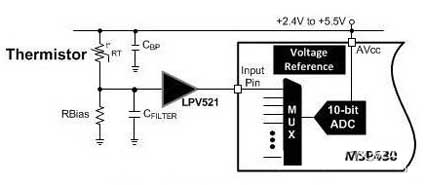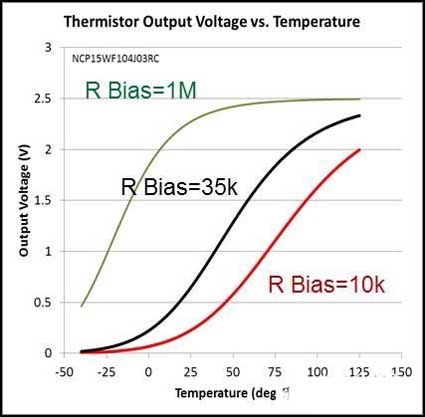Thermistor temperature sensing circuit design solution
Choosing the right temperature sensor not only saves money, but also maximizes system performance. In this blog post, I will mainly talk about thermistors and analog temperature sensors, both of which are cost effective temperature sensing solutions. The question is, how do you know which one to choose?
Technically, a thermistor is a resistor whose resistance changes with temperature. As shown in Figure 1, a bias circuit and a few external components are required, where the bias resistor and the thermistor form a voltage divider and are connected to an optional operational amplifier. The amplifier is connected to an analog-to-digital converter (ADC) of a microcontroller (MCU) to convert the resistance value of the thermistor into a temperature value.

Figure 1 The structure diagram of the thermistor bias circuit and external components designed by Yaxun Electronics

figure 2: The relationship between the thermistor output voltage and temperature
For some reason, where unpredictability and power consumption are not critical, thermistors are best suited for temperature measurements over a narrow temperature range. An analog temperature sensor is an active semiconductor device whose output is a voltage or current value proportional to temperature. As an integrated circuit (IC), the analog temperature sensor has built-in intelligence that is not available in the thermistor, making design work related to analog temperature sensors simple.
Technically, a thermistor is a resistor whose resistance changes with temperature. As shown in Figure 1, a bias circuit and a few external components are required, where the bias resistor and the thermistor form a voltage divider and are connected to an optional operational amplifier. The amplifier is connected to an analog-to-digital converter (ADC) of a microcontroller (MCU) to convert the resistance value of the thermistor into a temperature value.

Figure 1 The structure diagram of the thermistor bias circuit and external components designed by Yaxun Electronics
The advantage of the thermistor is its low cost. In addition, as a resistor, it can be housed in a very small two-terminal package and placed in a wired probe.
The disadvantage of the thermistor is that its output is linear and accurate only over a narrow temperature range, and becomes non-linear outside of this range. Figure 2 plots the output curves of three thermistors with biasing resistances of 1 MΩ, 35 kΩ, and 10 kΩ, respectively. Each curve is linear over a narrow temperature range, but the three curves are non-linear when the bias resistance is 1 MΩ, 35 kΩ, and 10 kΩ, respectively, and the temperatures are 10oC, 75oC, and 50oC, respectively. Although a specially calibrated thermistor can be used to achieve the target accuracy for a specific temperature, the thermistor is costly, and the three different devices also make inventory management too complicated. Other disadvantages include unpredictable failures, low immunity, and high power consumption.
The disadvantage of the thermistor is that its output is linear and accurate only over a narrow temperature range, and becomes non-linear outside of this range. Figure 2 plots the output curves of three thermistors with biasing resistances of 1 MΩ, 35 kΩ, and 10 kΩ, respectively. Each curve is linear over a narrow temperature range, but the three curves are non-linear when the bias resistance is 1 MΩ, 35 kΩ, and 10 kΩ, respectively, and the temperatures are 10oC, 75oC, and 50oC, respectively. Although a specially calibrated thermistor can be used to achieve the target accuracy for a specific temperature, the thermistor is costly, and the three different devices also make inventory management too complicated. Other disadvantages include unpredictable failures, low immunity, and high power consumption.

figure 2: The relationship between the thermistor output voltage and temperature
For some reason, where unpredictability and power consumption are not critical, thermistors are best suited for temperature measurements over a narrow temperature range. An analog temperature sensor is an active semiconductor device whose output is a voltage or current value proportional to temperature. As an integrated circuit (IC), the analog temperature sensor has built-in intelligence that is not available in the thermistor, making design work related to analog temperature sensors simple.





